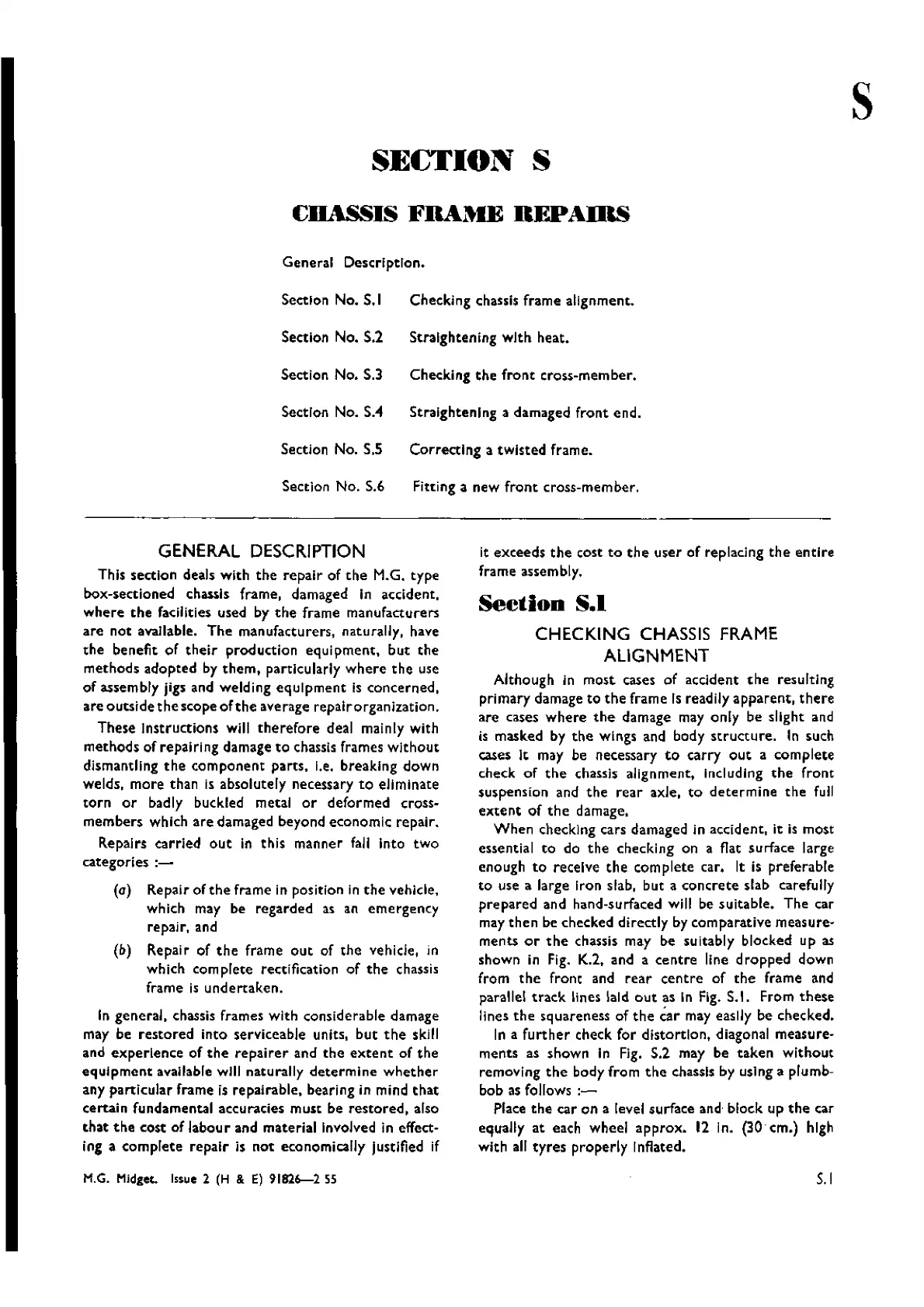SECTION S
CHASSIS
FRAME
REPADlS
General Description.
SectIon No. 5.1 Checking chassis frame alignment.
Section No. 5.2 Straightening
with
heat.
Section No. 5.3 Checking
the
front
cross-member.
Section No. SA Straightening a damaged
front
end.
Section No. S.5
Correcting
a
twisted
frame.
Section No. 5.6 Fitting a new
front
cross-member.
s
GENERAL DESCRIPTION
This section deals with
the
repair
of
the
M.G. type
box-sectioned chassis frame, damaged in accident.
where
the
facilities used by
the
frame manufacturers
are
not
available.
The
manufacturers, naturally, have
the
benefit
of
their
production
equipment,
but
the
methods adopted by
them.
particularly
where
the
use
of assembly jigs and welding
equipment
Is concerned,
are
outside
t he scopeof
the
average repal r 0 rganlzation.
These Instructions will
therefore
deal mainly with
methods of repairing damage
to
chassis frames
without
dismantling
the
component
parts.
r.e,
breaking down
welds,
more
than is absolutely necessary
to
eliminate
torn
or
badly buckled metal
or
deformed cross-
members which
are
damaged beyond economic repair.
R.epalrs carried
out
in this manner fall into
two
categories
:-
(a) Repair of
the
frame in pasition in
the
vehicle,
which may be regarded as an emergency
repair, and
(b) Repair of
the
frame
out
of
the
vehicle, in
which complete rectification of
the
chassis
frame is
undertaken.
In general, chassis frames with considerable damage
may be
restored
into
serviceable units,
but
the
skill
and
experience
of
the
repairer
and
the
extent
of
the
equipment
available will naturally
determine
whether
any particular frame is repairable. bearing in mind
that
certain fundamental accuracies
must
be
restored,
also
that
the
cost of labour and material Involved in effect-
ing a
complete
repair is
not
economically justified if
M.G. Midget.
Issue
2 (H & E)
91826-255
it exceeds
the
cost
to
the
user
of
replacing
the
entire
frame assembly.
Section
S.I
CHECKING CHASSIS FRAME
ALIGNMENT
Although in
most
cases of accident
the
resulting
primary damage
to
the
frame Is readily
apparent,
there
are cases
where
the
damage may only be slight and
is masked by
the
wings and body
structure.
In such
cases It
may
be necessary
to
carry
out
a complete
check of
the
chassis alignment. Including
the
front
suspension and
the
rear
axle.
to
determine
the
full
extent
of
the
damage.
When
checkIng cars damaged In accident, it is most
essential
to
do
the
checking on a flat surface large
enough
to
receive
the
complete car. It Is preferable
to
use a large iron slab, but a
concrete
slab carefully
prepared
and hand-surfaced will be suitable. The car
may
then
be checked directly by comparative measure-
ments
or
the
chassis may be suitably blocked up as
shown in Fig. K.2. and a
centre
line
dropped
down
from
the
front and
rear
centre
of
the
frame and
parallel
track
lines laid
out
as In Fig. 5.1. From
these
lines
the
squareness of
the
car
may easily be checked.
In a
further
check for
distortion.
diagonal measure-
ments as shown in Fig. 5.2 may be
taken
without
removing
the
body from
the
chassis by using a plumb-
bob as follows
:-
Place
the
car on a level surface
and-
block up
the
car
equally at each wheel approx. 12 In. (30- cm.) hIgn
with all
tyres
properly Inflated.
5.1
Wishvilles Classic
Automobile Library

